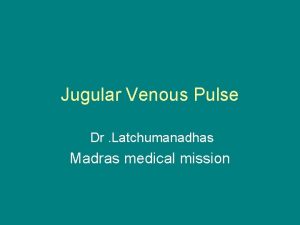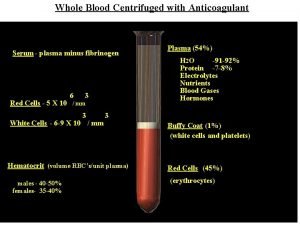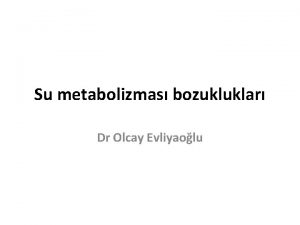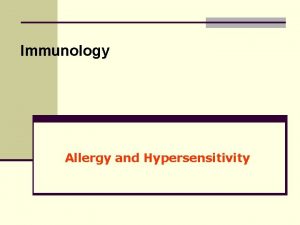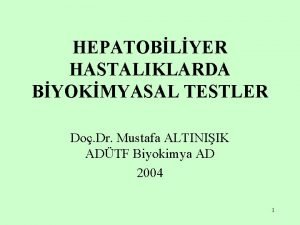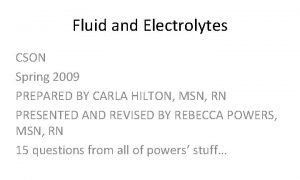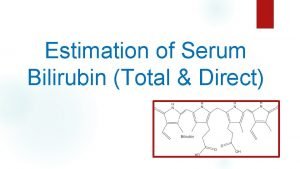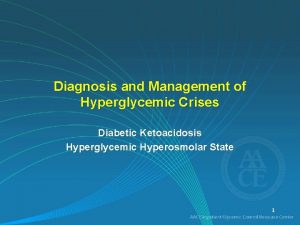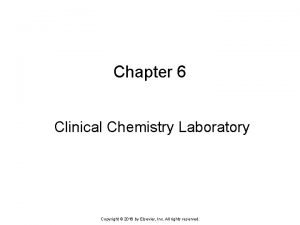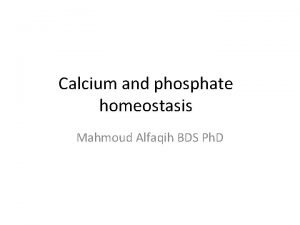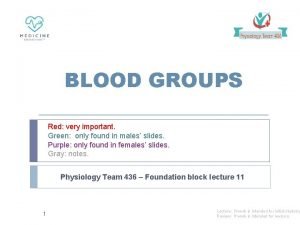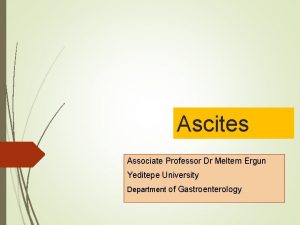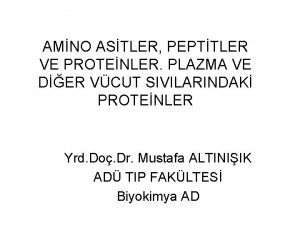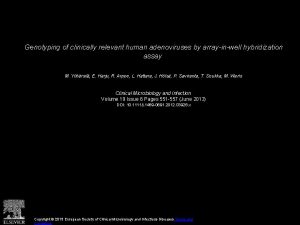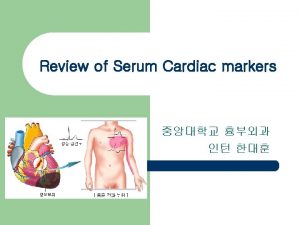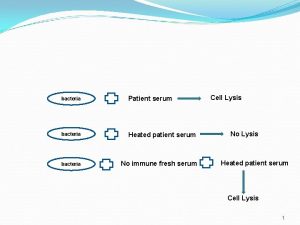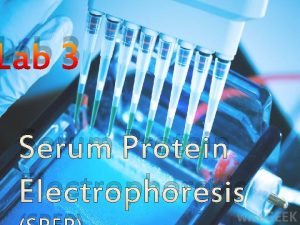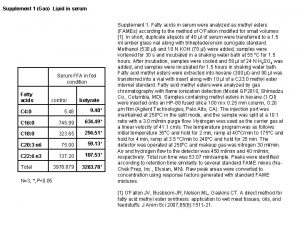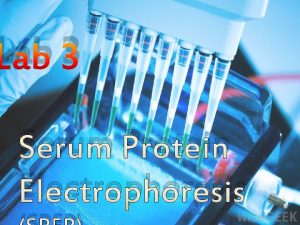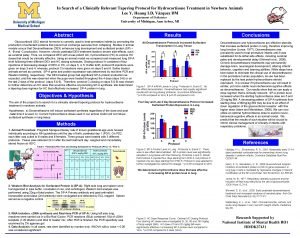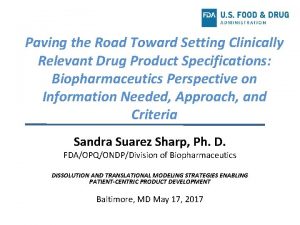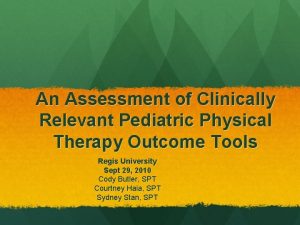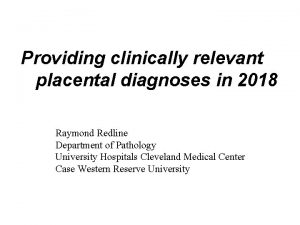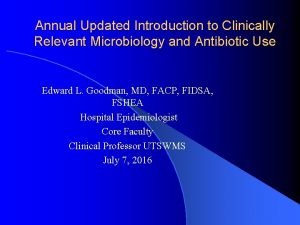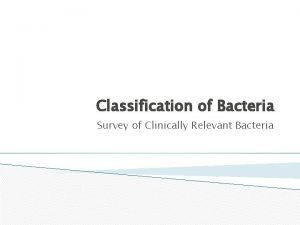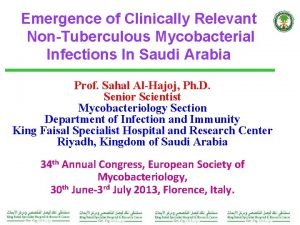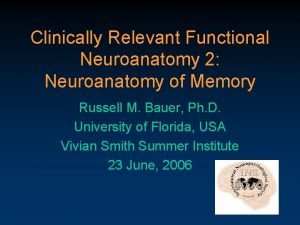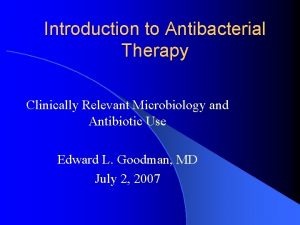Development of clinically relevant tests from human serum

























- Slides: 25

Development of clinically relevant tests from human serum samples: a look at the circulating proteome Heinrich Roder, Biodesix Inc. Rocky 19

Outline • The circulating proteome • Machine learning, “Big Data” and “Deep Data” • Diagnostic Cortex® platform – machine learning approach optimized for Deep Data setting • Incorporating elements of traditional and modern machine learning • Examples of validated, clinically relevant molecular diagnostic development based on the circulating proteome • Biology • Set enrichment analysis of proteomic tests © 2019 Biodesix, Inc. All rights reserved. 2

The Circulating Proteome

The Circulating Proteome and Cancer Immunology The circulating proteome may reflect the host immune state. ü The circulating proteome is derived from tumor, tumor microenvironment, and normal host tissues 1 ü The circulating proteome changes during tumor development and as a result of treatment ü Circulating proteins have direct regulatory effects on the immune system Dynamic range of circulating proteins 2 From pre-treatment samples Biodesix developed and validated multiple tests for different indications combining measurements of circulating proteome with outcome data via modern machine learning. 1 S. Pitteri et al. Cancer Research (2011) ; 2 Gautam P et al. (2013) © 2019 Biodesix, Inc. All rights reserved. Proprietary and confidential. 4

Machine learning, Big Data and Deep Data © 2019 Biodesix, Inc. All rights reserved. 5

Impacts of machine learning and artificial intelligence Everyday life • NLP, speech recognition (smart speakers, phones, call centers, …) • Image recognition (Google Images, facial recognition, …. ) • Recommender systems (search engines, shopping, …) Software as a Medical Device • “FDA permits marketing of clinical decision support software for alerting providers of a potential stroke in patients”, 2/13/2018 (https: //www. fda. gov/news-events/press-announcements/fda-permits-marketingclinical-decision-support-software-alerting-providers-potential-stroke) • “FDA permits marketing of artificial intelligence-based device to detect certain diabetes-related eye problems, 4/11/2018 (https: //www. fda. gov/news-events/press-announcements/fda-permits-marketing-artificialintelligence-based-device-detect-certain-diabetes-related-eye) • “FDA permits marketing of artificial intelligence algorithm for aiding providers in detecting wrist fractures, 5/24/2018 (https: //www. fda. gov/news-events/press-announcements/fda-permits-marketing-artificialintelligence-algorithm-aiding-providers-detecting-wrist-fractures © 2019 Biodesix, Inc. All rights reserved. 6

Why can’t we use ‘out-of-the-box’ deep learning nets? Deep Learning works well with Big Data (very many training examples) “As of 2016, a rough rule of thumb is that a supervised deep learning algorithm will generally achieve acceptable performance with around 5, 000 labeled training examples per category and will match or exceed human performance when training with a dataset containing at least 10 million labeled examples. ” - Deep Learning, Goodfellow, Bengio, and Courville, MIT Press 2017 Molecular diagnostics problems are characterized by few training examples and Deep Data • • Curse of dimensionality (“p>N”, i. e. more attributes (features) than samples) Data augmentation difficult © 2019 Biodesix, Inc. All rights reserved. 7

What aspects of deep learning can we use? ü Hierarchical approaches ü Abstractive approaches ü Avoid feature selection by allowing the machine to decide how to combine all attributes ü Regularization (methods used to solve an ill-posed problem or prevent overfitting): deep learning makes extensive use of regularization, often by “drop-out” 1 And from traditional machine learning: ü Ensemble averaging (“bagging” 2) ü “Boosting” 3 References: 1. Srivastava et al, J Mach Learn Res 15: 1929 (2014); 2. Breiman, Mach Learn 24: 123 (1996); 3. Shapire, Mach Learn 5: 197 (1990). © 2019 Biodesix, Inc. All rights reserved. 8

How should we incorporate subject matter expertise? ü Do use subject matter knowledge for things the ML cannot learn: ü Assessing suitability of training set (population, confounders) ü Defining clinically relevant endpoints to measure test performance ü Preprocessing of proteomic/genomic data Minimization of batch effects Correcting for differences between data measurement platforms Preprocessing to maximize data accuracy and reproducibility Do not use subject matter knowledge for things the ML can learn: × Selecting features/attributes to include in the ML × Constraining the learning to yield an “easy-to-understand” model © 2019 Biodesix, Inc. All rights reserved. 9

Diagnostic Cortex® Platform: A machine learning platform optimized for the design of molecular diagnostic tests © 2019 Biodesix, Inc. All rights reserved. 10

The Diagnostic Cortex Platform References: Roder et al, BMC Bioinformatics 20: 325 (2019). © 2019 Biodesix, Inc. All rights reserved. 11

Ensemble Averaging - “bagging” ü Minimize risk of overfitting ü Avoid extremes in test or training sets ü Get reliable (‘test set’) classifications for all samples via “out-of-bag estimates” 2 ü Reliable test performance estimates from development set References: 1. Breiman, Mach Learn 24: 123 (1996); 2. Breiman Stanford University Technical Report (1996). © 2019 Biodesix, Inc. All rights reserved. 12

Abstraction and Hierarchy ü Increase robustness to noise in input data ü “Information bottleneck” 1 ü Learning on multiple levels References: 1. Tishby et al, ar. Xiv: physics/0004057 [physics. data-an]; © 2019 Biodesix, Inc. All rights reserved. 13

Regularization via “drop-out” ü No need for feature ü reduction or selection ü Minimize risk of overfitting References: 1. Srivastava et al, J Mach Learn Res 15: 1929 (2014); 3. Shapire, Mach Learn 5: 197 (1990). © 2019 Biodesix, Inc. All rights reserved. 14

Definition of Training Classes Assigning training class labels Generate test and training labels simultaneously… • Training class labels can have errors, e. g. histology • Gold standard endpoints (e. g. overall survival) may not be categorical • It may not be clear from outcome data who benefits from therapy We want to discover a robust molecular phenotype associated with a clinically relevant endpoint • Molecular data have measurement errors • Training data (instances) give sparse coverage of molecular feature space 5 4 Iterate to convergence Build a new test for these new labels Start with a guess of labels At convergence we find labels that are consistent with the molecular data. 1 Build a test for these labels 2 Classify samples and use the classifications as new training labels 3 References: Roder et al, BMC Bioinformatics 20: 273 (2019) © 2019 Biodesix, Inc. All rights reserved. 15

Illustration with Synthetic Data Create a dataset with 1, 000 attributes measured for 60 samples each for 2 phenotypes 1 and 2. • Phenotypes 1 and 2 defined by distribution of attributes • Attributes assigned at random • Survival assigned at random, survival rescaled for Phenotype 2 depending on attribute values to give this phenotype worse prognosis. Kaplan-Meier plots of dataset, Hazard ratio = 0. 75 References: Roder et al, BMC Bioinformatics 20: 273 (2019) © 2019 Biodesix, Inc. All rights reserved. t-SNE plots of development set samples with initial training class labels and final classification labels a. Initial median dichotomized b. initial classifier results c. results after 1 iteration d. final results (2 iterations) 16

Applications © 2019 Biodesix, Inc. All rights reserved. 17

Detection of Primary Immunoresistance in Melanoma Across different immunotherapies in melanoma CP test in anti-PD 1 (N=119) CP test in anti-CTLA (N=48) HD-IL 2 test (N=114) Two separate tests developed for checkpoint efficacy (CP)1 and high dose IL-2 (HD-IL 2) benefit 2 identify a group of patients that may obtain little long term benefit from anti-PD 1, anti-CTLA 4, and HD-IL 2 treatment. • Test classifications are independent predictors of outcomes when adjusted for other markers, such as LDH and PD-L 1 expression References: 1. Weber at al, Cancer Immunol Res 6: 79 (2018); 2. Sullivan et al. J Immunother Cancer 4(Suppl): 6 (2016). © 2019 Biodesix, Inc. All rights reserved. 18

Detection of Primary Immunoresistance in NSCLC • A test was developed to identify patients with primary resistance on single arm data (atezolizumab specific test) • Results from fully blinded validation on POPLAR: Phase II, randomized study of atezolizumab vs. docetaxel OS PFS interaction p = 0. 001 interaction p = 0. 005 References: Kowanetz et al, J Immunother Cancer 6(Suppl 1): 114 (2018). © 2019 Biodesix, Inc. All rights reserved. 19

Detection of HCC in high risk population Development set Internal validation set Independent validation set Test shows significantly improved performance over current biomarker, AFP. It is able to detect small/early stage tumors (100% sensitivity for tumors <3 cm, 75% sensitivity stage I (independent validation)) where curative approaches are feasible. References: Lee et al, Cancer Res 79(13 Suppl) 4530 (2019). © 2019 Biodesix, Inc. All rights reserved. 20

Set Enrichment Analysis

Protein Set Enrichment Analysis • Uses a reference set with well characterized protein data: Soma. Logic • Proteins related to process from databases (Amigo, GO): Complement, wound healing, IR 17, … ( e. g. Hallmark set) • Power of set enrichment analysis can be increased by bagging • Also allows to combine different reference sets • Uses: • Association of test defined phenotypes with biological processes • Association of mass spec peaks with processes score related to a process Subramanian, A. et al Proc Natl Acad Sci U S A 102, 15545 -50 (2005). Grigorieva, J. et al. Clinical Mass Spectrometry 2019. https: //doi. org/10. 1016/j. clinms. 2019. 001. Roder J, et al. BMC Bioinformatics 2019, 20(1): 257. © 2019 Biodesix, Inc. All rights reserved. 22

Example: What Characterizes Patients with IO Resistance? Association of sensitive and resistant groups with biological processes (subset) PSEA Signaling process Nivolumab Melanoma HD-IL 2 Melanoma Atezolizumab Nivolumab NSCLC Acute inflammatory response NS p < 0. 01 p <0. 10 p < 0. 10 Activation of innate immune response NS NS Regulation of adaptive immune response NS NS Positive regulation of glycolytic process NS NS Immune T-cells NS NS Immune B-cells NS NS Extra cellular matrix NS NS NS p < 0. 01 Natural killer regulation NS NS Complement system p < 0. 05 p < 0. 01 p < 0. 10 p < 0. 01 Wound healing p < 0. 01 p < 0. 05 NS p < 0. 01 Interferon NS NS Interleukin-10 NS NS NS p < 0. 10 Growth factor receptor signaling NS NS Immune Response Type 1 NS NS Immune Response Type 2 NS NS p < 0. 10 p < 0. 01 NS p < 0. 01 Acute phase Across indications resistant patients have elevated levels of: • Acute inflammatory processes • Complement • Wound healing In NSCLC IR 2 and ECM (for nivolumab) are elevated in poor outcome groups. Similar effects were seen by others, e. g. : Ø Combined blockade of complement signaling and anti-PD-1 can enhance anti-PD-1 efficacy; Cancer Discovery 6 (9) : 1022 -35 June 2017 Ø A transcriptional signature (IPRES) identified related to innate anti-PD-1 resistance; wound healing is one of the pathways; Cell 165: 35 -44 March 2017 NS: Not significant © 2019 Biodesix, Inc. All rights reserved. 23

Summary • Ideas from traditional machine learning can be combined with concepts from deep learning to develop multivariate tests even in the p >> N setting. • Using bagging one can reliably estimate effect sizes even from small development sets. • The circulating proteome is informative for primary resistance to checkpoint inhibition. • Set enrichment analysis can be used to elucidate biological underpinnings of multivariate tests. © 2019 Biodesix, Inc. All rights reserved. 24

Acknowledgments Biodesix Research Team External collaborations Joanna Roder Carlos Oliveira Arni Steingrimsson Lelia Net Julia Grigorieva Maxim Tsypin Senait Asmellash Krista Meyer Benjamin Linstid Conde Benoist Brandon Touchet Steven Rightmyer J Weber (NYU) M Sznol, H Kluger, R Halaban (Yale) R Sullivan (MGH) P Ascierto (Naples, Italy) D Mahalingam (Northwestern) L Chelis (Dammam, Saudi Arabia) R Iyer (Roswell Park) S Lee (MD Anderson) © 2019 Biodesix, Inc. All rights reserved. 25
 How to measure jvp
How to measure jvp Jvp normal
Jvp normal How to measure jvp
How to measure jvp Ace different tests help iq still
Ace different tests help iq still Cna chapter 8 human needs and human development
Cna chapter 8 human needs and human development Chapter 8 human needs and human development
Chapter 8 human needs and human development Human development index definition ap human geography
Human development index definition ap human geography Blood plasma minus fibrinogen is
Blood plasma minus fibrinogen is Osmotic demyelination syndrome risk factors
Osmotic demyelination syndrome risk factors Osmolalite (serum/plazma)
Osmolalite (serum/plazma) Serum osmolality formula
Serum osmolality formula Plasma and serum separation
Plasma and serum separation Serum sickness hypersensitivity type
Serum sickness hypersensitivity type Lösin aminopeptidaz testi nedir
Lösin aminopeptidaz testi nedir Serum osmolarity formula
Serum osmolarity formula Slidetodoc
Slidetodoc Xanthomes plis palmaires
Xanthomes plis palmaires Estimation of bilirubin
Estimation of bilirubin Serum osmolarity formula
Serum osmolarity formula Difference between end point and kinetic reaction
Difference between end point and kinetic reaction Normal range calcium
Normal range calcium Blood groups
Blood groups Difference between plasma and serum
Difference between plasma and serum Semmelweis
Semmelweis Meltem ergun
Meltem ergun Lösin enkefalin nedir
Lösin enkefalin nedir

